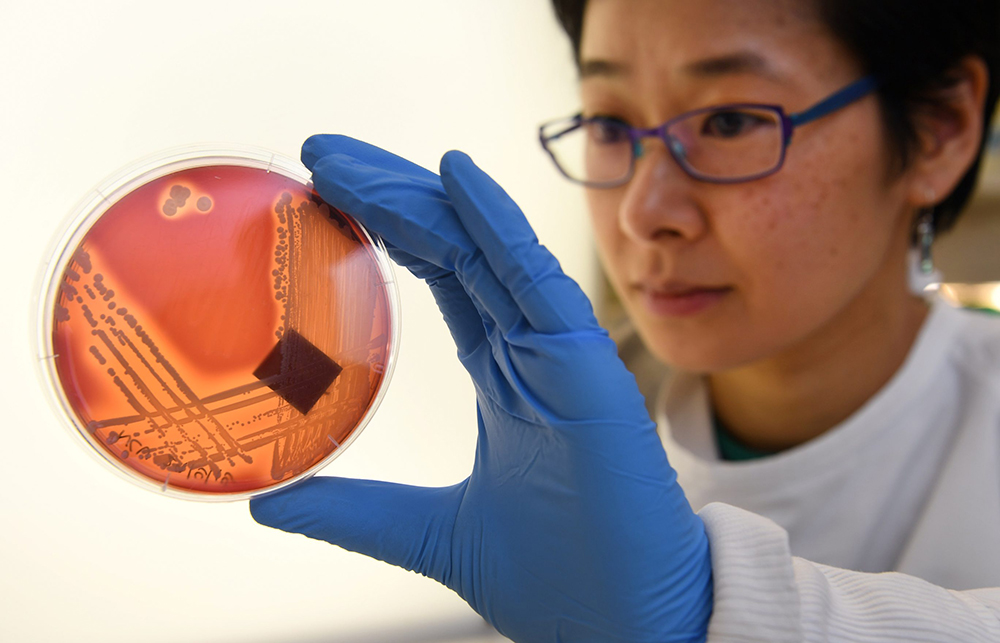
想象一下,一個孩子在操場上擦破了膝蓋并且傷口被感染,。急診室里的醫(yī)生向家屬保證說,,抗生素會讓事情好轉(zhuǎn)。
然而抗生素并沒有發(fā)揮作用,,其它方法似乎也不奏效,。感染迅速惡化,挽救這個孩子生命的唯一方法是截肢,。
這種噩夢般的場景在未來幾年可能會變得常見起來,。今天,“超級細(xì)菌”——也就是對幾乎所有抗生素都有耐藥性的細(xì)菌和真菌——變得越來越普遍,。例如,,人們發(fā)現(xiàn)一種新出現(xiàn)的真菌——耳念珠菌(Candida Auris)——對當(dāng)前所有的治療方法都有耐藥性。
如果沒有更強(qiáng)大的新抗菌藥出現(xiàn),,一場尋常的游樂場之行都可能以悲劇收場,。
細(xì)菌和真菌天然能產(chǎn)生耐藥性。如果有人得了肺炎并服用抗生素,,大多數(shù)導(dǎo)致肺炎的細(xì)菌會被殺滅,,但某些細(xì)菌會因為基因突變而存活下來。這些幸存者進(jìn)行自我繁殖,,如果不加以控制,,可能導(dǎo)致無法治愈的肺炎,除非我們擁有這些耐藥細(xì)菌從未遇到過的抗生素,。
出于這個原因,,我們將不停地需要新的抗生素。如果科學(xué)家不盡快發(fā)現(xiàn)新的抗生素,,世界最終將回到一個小小的傷口就能致命的前抗生素時代,。
根據(jù)世界衛(wèi)生組織的數(shù)據(jù),,超級細(xì)菌已經(jīng)導(dǎo)致全球每年70萬人死亡。如果我們什么都不做,,這個數(shù)字到2050年將達(dá)到1000萬之多,。
不幸的是,由于市場機(jī)制的缺陷,,研發(fā)新抗生素的生物技術(shù)公司正面臨著一場艱苦戰(zhàn)斗,。
醫(yī)生在治療病人時必須謹(jǐn)慎考慮是否要使用最新的抗生素,因為每次使用這類藥物,,就給了細(xì)菌產(chǎn)生耐藥性的機(jī)會,。因此新的抗生素通常用量不大,這樣一來,,抗生素的研發(fā)企業(yè)幾乎沒有機(jī)會賣出足夠多的藥來收回研發(fā)成本,。
Achaogen公司的遭遇正是如此。在政府和風(fēng)投資金的幫助下,,該公司成功地開發(fā)出一種新的抗生素來治療耐藥感染,,并獲得了美國食藥監(jiān)局的上市批準(zhǔn)。然而這家公司還是破產(chǎn)了,,這種新型抗生素因此沒能被送到需要它的病人手中,。
Achaogen并不是個例。其它不少生物技術(shù)公司也不得不申請破產(chǎn)和重組,,包括持有四種獲批抗生素的Melinta公司,。
基于銷量而獲利的傳統(tǒng)商業(yè)模式眼下是行不通了,所以專注于研發(fā)抗生素的公司并不多,。目前只有43種抗生素處于研發(fā)階段,,相比之下,正在研發(fā)中的抗癌藥物有超過1000種之多,。
幾乎所有的抗生素研發(fā)都是由小型初創(chuàng)公司進(jìn)行的,它們背靠投資者的支持,。然而要找到投資者并不容易,,因為很少有人愿意對一種沒什么醫(yī)院會買的產(chǎn)品下注。
類似于波士頓大學(xué)的CARB-X這樣的公私合作企業(yè)能提供早期資金,,幫助有前途的項目早日啟動,。但將一種抗生素推向市場可能需要高達(dá)15億美元的投入。在領(lǐng)先的生物醫(yī)藥公司,、全球基金會和開發(fā)銀行的支持下,,抗生素耐藥性行動基金(AMR Action Fund)已承諾投資10億美元,在未來10年內(nèi)幫助兩到四種新的抗生素投入市場,。
盡管如此,,任何新的抗生素都需要一種新的市場機(jī)制,,才能避免與Achaogen一樣的命運(yùn)。
一些專家建議對新型抗生素采取奈飛(Netflix)式的訂閱模式,,即醫(yī)院或政府為所需用量支付一定的費(fèi)用,。科羅拉多州參議員邁克爾·本納特(Michael Bennet),、印第安納州參議員托德·楊(Todd Young),、賓夕法尼亞州眾議員邁克爾·多以勒(Michael Doyle)、喬治亞州眾議員朱·福古森(Drew Ferguson)最近提出了PASTEUR法案,,試圖在美國建立這樣一個模式,。
另一項法案——DISARM法案——將對適當(dāng)使用先進(jìn)抗生素的醫(yī)院進(jìn)行新型的醫(yī)保補(bǔ)償,同時提供一些必要的財政支持來推動更多的研發(fā),。像這樣的政策改革將有助于確保病人繼續(xù)獲得他們所需要的抗生素,。
我們需要一個新的抗生素市場機(jī)制,而且我們擁有應(yīng)對這一挑戰(zhàn)的政策工具箱?,F(xiàn)在,,就看我們的領(lǐng)導(dǎo)人如何執(zhí)行了。(財富中文網(wǎng))
本文作者米歇爾·麥克默里-希斯博士(Michelle McMurry-Heath)是一名醫(yī)學(xué)家,,也是生物技術(shù)創(chuàng)新組織(Biotechnology Innovation Organization)的總裁和首席執(zhí)行官,。亨利·斯肯那(Henry Skinner)博士是抗生素耐藥性行動基金的首席執(zhí)行官。
譯者:珠珠
想象一下,,一個孩子在操場上擦破了膝蓋并且傷口被感染,。急診室里的醫(yī)生向家屬保證說,抗生素會讓事情好轉(zhuǎn),。
然而抗生素并沒有發(fā)揮作用,,其它方法似乎也不奏效。感染迅速惡化,,挽救這個孩子生命的唯一方法是截肢,。
這種噩夢般的場景在未來幾年可能會變得常見起來。今天,,“超級細(xì)菌”——也就是對幾乎所有抗生素都有耐藥性的細(xì)菌和真菌——變得越來越普遍,。例如,人們發(fā)現(xiàn)一種新出現(xiàn)的真菌——耳念珠菌(Candida Auris)——對當(dāng)前所有的治療方法都有耐藥性,。
如果沒有更強(qiáng)大的新抗菌藥出現(xiàn),,一場尋常的游樂場之行都可能以悲劇收場。
細(xì)菌和真菌天然能產(chǎn)生耐藥性,。如果有人得了肺炎并服用抗生素,,大多數(shù)導(dǎo)致肺炎的細(xì)菌會被殺滅,但某些細(xì)菌會因為基因突變而存活下來。這些幸存者進(jìn)行自我繁殖,,如果不加以控制,,可能導(dǎo)致無法治愈的肺炎,除非我們擁有這些耐藥細(xì)菌從未遇到過的抗生素,。
出于這個原因,,我們將不停地需要新的抗生素。如果科學(xué)家不盡快發(fā)現(xiàn)新的抗生素,,世界最終將回到一個小小的傷口就能致命的前抗生素時代,。
根據(jù)世界衛(wèi)生組織的數(shù)據(jù),超級細(xì)菌已經(jīng)導(dǎo)致全球每年70萬人死亡,。如果我們什么都不做,,這個數(shù)字到2050年將達(dá)到1000萬之多。
不幸的是,,由于市場機(jī)制的缺陷,,研發(fā)新抗生素的生物技術(shù)公司正面臨著一場艱苦戰(zhàn)斗。
醫(yī)生在治療病人時必須謹(jǐn)慎考慮是否要使用最新的抗生素,,因為每次使用這類藥物,,就給了細(xì)菌產(chǎn)生耐藥性的機(jī)會。因此新的抗生素通常用量不大,,這樣一來,,抗生素的研發(fā)企業(yè)幾乎沒有機(jī)會賣出足夠多的藥來收回研發(fā)成本。
Achaogen公司的遭遇正是如此,。在政府和風(fēng)投資金的幫助下,,該公司成功地開發(fā)出一種新的抗生素來治療耐藥感染,并獲得了美國食藥監(jiān)局的上市批準(zhǔn),。然而這家公司還是破產(chǎn)了,,這種新型抗生素因此沒能被送到需要它的病人手中。
Achaogen并不是個例,。其它不少生物技術(shù)公司也不得不申請破產(chǎn)和重組,,包括持有四種獲批抗生素的Melinta公司。
基于銷量而獲利的傳統(tǒng)商業(yè)模式眼下是行不通了,,所以專注于研發(fā)抗生素的公司并不多,。目前只有43種抗生素處于研發(fā)階段,相比之下,,正在研發(fā)中的抗癌藥物有超過1000種之多。
幾乎所有的抗生素研發(fā)都是由小型初創(chuàng)公司進(jìn)行的,,它們背靠投資者的支持,。然而要找到投資者并不容易,因為很少有人愿意對一種沒什么醫(yī)院會買的產(chǎn)品下注。
類似于波士頓大學(xué)的CARB-X這樣的公私合作企業(yè)能提供早期資金,,幫助有前途的項目早日啟動,。但將一種抗生素推向市場可能需要高達(dá)15億美元的投入。在領(lǐng)先的生物醫(yī)藥公司,、全球基金會和開發(fā)銀行的支持下,,抗生素耐藥性行動基金(AMR Action Fund)已承諾投資10億美元,在未來10年內(nèi)幫助兩到四種新的抗生素投入市場,。
盡管如此,,任何新的抗生素都需要一種新的市場機(jī)制,才能避免與Achaogen一樣的命運(yùn),。
一些專家建議對新型抗生素采取奈飛(Netflix)式的訂閱模式,,即醫(yī)院或政府為所需用量支付一定的費(fèi)用??屏_拉多州參議員邁克爾·本納特(Michael Bennet),、印第安納州參議員托德·楊(Todd Young)、賓夕法尼亞州眾議員邁克爾·多以勒(Michael Doyle),、喬治亞州眾議員朱·福古森(Drew Ferguson)最近提出了PASTEUR法案,,試圖在美國建立這樣一個模式。
另一項法案——DISARM法案——將對適當(dāng)使用先進(jìn)抗生素的醫(yī)院進(jìn)行新型的醫(yī)保補(bǔ)償,,同時提供一些必要的財政支持來推動更多的研發(fā),。像這樣的政策改革將有助于確保病人繼續(xù)獲得他們所需要的抗生素。
我們需要一個新的抗生素市場機(jī)制,,而且我們擁有應(yīng)對這一挑戰(zhàn)的政策工具箱?,F(xiàn)在,就看我們的領(lǐng)導(dǎo)人如何執(zhí)行了,。(財富中文網(wǎng))
本文作者米歇爾·麥克默里-希斯博士(Michelle McMurry-Heath)是一名醫(yī)學(xué)家,,也是生物技術(shù)創(chuàng)新組織(Biotechnology Innovation Organization)的總裁和首席執(zhí)行官。亨利·斯肯那(Henry Skinner)博士是抗生素耐藥性行動基金的首席執(zhí)行官,。
譯者:珠珠
Imagine a child scrapes his knee on the playground. The wound gets infected. At the ER, the doctor assures the family an antibiotic will make things fine.
But it doesn't–and nothing else seems to work. Soon, the infection grows worse, and the only way to save the child's life is to amputate.
This nightmarish scenario could become common in the coming years. Today, "superbugs"–bacteria and fungi resistant to virtually all antimicrobials–are increasingly prevalent. For example, Candida Auris, an emerging fungus that is proving to be resistant to all available treatments.
Without new, more powerful antimicrobials, a simple visit to a playground could end in unspeakable tragedy.
It's in the nature of bacteria and fungi to develop antimicrobial resistance (AMR). If someone has pneumonia and is prescribed antibiotics, most of the pneumonia-causing bacteria will die. But some survive due to genetic luck. These survivors then reproduce. Unchecked, this strain of bacteria could cause incurable pneumonia, unless we have an antibiotic that these resistant bacteria have never met.
For this reason, we’ll always need new antibiotics. If scientists don't discover new antibiotics soon, the world will eventually return to the pre-antibiotic era when simple cuts could kill.
Already, superbugs kill 700,000 people worldwide annually, according to the World Health Organization. If we do nothing, they'll kill 10 million every year by 2050.
Unfortunately, biotech companies trying to discover new antibiotics face an uphill battle because the market is flawed.
Doctors must be careful when they consider treating their patients with the newest antibiotics, because every time these drugs are used, bacteria have a chance to build resistance. As a result, new antibiotics are generally used sparingly–leaving antibiotic companies with little chance of selling enough doses to recoup their investment.
That's what happened with Achaogen. With the help of government and venture capital investment, the company successfully developed a new FDA-approved antibiotic to treat resistant infections. But it still went bankrupt. So, the novel antibiotic is not reaching patients who need it.
Achaogen isn't alone. Other biotechs have also been forced to file for bankruptcy and restructure, including Melinta, a company with four approved antibiotics.
Given that the traditional, volume-based model isn't currently working, it's no surprise there aren't many companies focused on antibiotic development. There are just 43 antibiotics in the development pipeline, compared to over 1,000 drugs for cancer.
Nearly all the antibiotic R&D is being done by small startups that rely on investors, but finding investors is difficult, as few want to bet on products few hospitals will buy.
Public-private partnerships like CARB-X out of Boston University provide early-stage funding that can help launch promising projects. But it can take $1.5 billion to bring an antibiotic to market. With support from leading biopharmaceutical firms, global foundations, and development banks, the AMR Action Fund has promised to invest $1 billion to help bring two to four new antibiotics to market over the next 10 years.
However, any new antibiotic will need a new marketplace dynamic to avoid the same fate as Achaogen.
Some experts have suggested a Netflix-style subscription model for novel antimicrobials, where hospitals or governments pay a fee for as much or as little is needed. Senators Michael Bennet (D-CO) and Todd Young (R-IN)–along with Representatives Michael Doyle (D-PA) and Drew Ferguson (R-GA)–recently introduced the PASTEUR Act, which would create such a model in the U.S.
Another bill, the DISARM Act, would modernize Medicare reimbursement for hospitals that appropriately use advanced antibiotics and, in turn, help provide some necessary financial assurance to fuel more research and development. Policy reforms like these will help ensure patients continue to have access to the antibiotics they need.
We need a new model for the antibiotics market. We have the policy toolkit to address the challenge. It's on our leaders to execute.
Dr. Michelle McMurry-Heath is a physician-scientist and the president and CEO of the Biotechnology Innovation Organization. Dr. Henry Skinner is the CEO of the AMR Action Fund.






